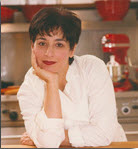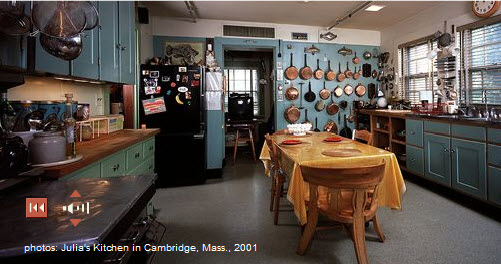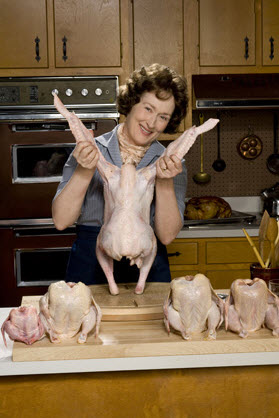 Marcy Goldman is a new friend. I met Marcy some time ago, and we just seem to hit it off really well. I respect Marcy's hard work and experience as a talented baker and chef. I wanted to celebrate the movie Julie and Julia, and while I'm sure I will have more to say about Julia Child's kitchen, I want to start off with this very wonderful and interesting piece, written by my new friend Marcy.
Marcy Goldman is a new friend. I met Marcy some time ago, and we just seem to hit it off really well. I respect Marcy's hard work and experience as a talented baker and chef. I wanted to celebrate the movie Julie and Julia, and while I'm sure I will have more to say about Julia Child's kitchen, I want to start off with this very wonderful and interesting piece, written by my new friend Marcy.
Marcy Goldman is a cookbook author and master baker, and the creator of BetterBaking.com. She is an occasional baking guest on Martha Stewart Sirius and this fall has two new cookbooks coming out, as well as the current A Passion for Baking, Oxmoor House 2007. Follow Marcy on Twitter.
Marcy's newest cookbooks, A Treasury of Jewish Holiday Baking, and The New Best of Betterbaking.com, both Whitecap Books, will be available September 2009.
Get Marcy's book here: A Passion for Baking: Bake to celebrate, Bake to nourish, Bake for funHere's Marcy, in her own words, talking about Julia Child's kitchen. Enjoy.

I am both a curious chef and a nosy person. While in line at the supermarket, I find I peek at everyone’s grocery order and draw conclusions. Vegan, bachelor, busy working mom, non-cook, potential baker, meat lover, healthy eater, new dieter, and the family and/or must-have-tons-of-kids – those are some main categories. I observe more than actually spy, and I hope I am merely playing food and lifestyle sleuth – and not judging. I am just – as most food people are – interested in everything to do with food.
 So when I gaze at Julia Child’s kitchen, now enthroned at the Smithsonian Institute, complete with Julia’s own voice inviting you to visit her famed home kitchen from Cambridge, I am both curious – as if I was a neighbor strolling through, and as a fellow chef and cookbook author. What does this kitchen say to me? What sort of person lived and worked here? On occasion of Julie and Julia, the new Nora Ephron movie, I felt a need to go behind the movies and myth and revisit the real thing.
So when I gaze at Julia Child’s kitchen, now enthroned at the Smithsonian Institute, complete with Julia’s own voice inviting you to visit her famed home kitchen from Cambridge, I am both curious – as if I was a neighbor strolling through, and as a fellow chef and cookbook author. What does this kitchen say to me? What sort of person lived and worked here? On occasion of Julie and Julia, the new Nora Ephron movie, I felt a need to go behind the movies and myth and revisit the real thing.
The first thing I notice is that Julia was organized. There are acres of tools, pots, and pans – many choices, and a full battalion of back-up pans. I like that. That speaks of generosity too – a person who had a richesse insofar as she was outfitted with good stuff – not even lavish, but good stuff, easily at hand, and doubles of essentials. Brilliant. Such is the manner of my own kitchen.
I notice the good layout, the spaciousness, and the thoughtfulness in having things in easy reach and visually accessible. Chances are, if you see it, you’ll use it. If you hide tools and equipment away – true, your kitchen (and Julia’s) will look neat and streamlined but the very inspiration (and efficiency!) that comes from having visual reminders of potential culinary adventures cannot be overstated. You lose so much with things being hidden away – as aesthetic as it is, it robs you in other ways. Still, everything in its place, in a mindful way, is aesthetic in its own right. One takes a chance in being cluttered I suppose but Julia’s kitchen is inviting- not cluttered – so it’s possible to do it right.
 In Julia’s kitchen you also notice a fusion of objects that were meaningful or serviceable. Items brought back from travel, collectibles, and simply decent, basic, good quality cook and bake ware. There is a charming mix of heavy duty things like her Garland (a range I also have in my own kitchen), a huge sprawling table to work on and host meals on, as well as back-to-basics like choppers, mortar and pestle, and a sweet collection of tea tins. The tins are robin’s egg blue, as is much of the woodwork in the kitchen. Such a sweetness in that blue tone, with its hints of New England tradition, as well as a calm and cheeriness –also trademarks of Julia.
In Julia’s kitchen you also notice a fusion of objects that were meaningful or serviceable. Items brought back from travel, collectibles, and simply decent, basic, good quality cook and bake ware. There is a charming mix of heavy duty things like her Garland (a range I also have in my own kitchen), a huge sprawling table to work on and host meals on, as well as back-to-basics like choppers, mortar and pestle, and a sweet collection of tea tins. The tins are robin’s egg blue, as is much of the woodwork in the kitchen. Such a sweetness in that blue tone, with its hints of New England tradition, as well as a calm and cheeriness –also trademarks of Julia.
Without doubt, in sensibility and design, Julia’s place is an expansive kitchen, as befits Julia herself. It captures a hominess, hospitality, as well as the spirit of a serious cook and dedicated professional. It seems designed to suit Julia or a team of helpers both. It appears a kitchen that saw miles of food, good times, wonderful chats, and perhaps quiet toasts between just Julia, and her beloved Paul.
 Mostly, what I see when I take a glimpse of Julia’s kitchen, is a kitchen and a life, both well-lived. Chef or no, cookbook author or not, I would conclude this is the domain of a person I would like very much.
Mostly, what I see when I take a glimpse of Julia’s kitchen, is a kitchen and a life, both well-lived. Chef or no, cookbook author or not, I would conclude this is the domain of a person I would like very much.
What do our kitchens say about us? Our homes speak but our kitchens, the heart and hearth of our domain – sing our theme song to world and company we keep. Knowing this, seeing Julia’s kitchen, I think again of my own kitchen with new eyes. Like Julia’s, mine is a place of many recipes, many miles of hospitality. Like Julia’s kitchen, even in repose, there is an energy. Stilled rolling pins, cooled stove, measuring cups dangling from stainless steel hooks – it’s life, it’s a stage, it’s a fusion of love and food, in equal measure. It’s the perfect recipe. Always.
More information on Julia here: Smithsonian

